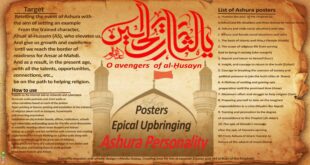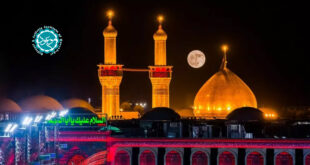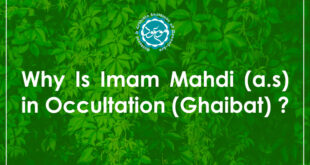People of all these cities enthusiastically welcomed and appreciated visiting the only descendant of the Holy Apostle (S) and took advantage of this opportunity to seek Imam (as)’s assistance in solving their religious and worldly problems.
Hadith Silsilat al-Dhahab (Golden Chain) (A tradition whose narrators are all Infallible Imams (as), relating one after another from the Holy Prophet (S) in Neyshabur
People of Neyshabur were eagerly looking forward to seeing Imam al-Ridha (as). At his arrival they asked him to stay on for a while longer so they could better see the charming and dignified countenance of the Prophet (S)’s grandson. Having dressed quite simply, the holy Imam (as) stood before the people.
Upon seeing the Imam (as), those people let out a cheerful chanting. When Imam al-Ridha (as) began to speak, two of the hadith memorizers named Abudhar‘a and Muhammad b. Aslam bade people to keep silent, and restated the graceful and elegant words of the holy Imam (as) loudly enough for all to hear. Imam al-Ridha (as) expressed a hadith regarding the unity and oneness of the Exalted Allah as follows:
“The statement La illaha illa Allah is My strong fortress, whoever says it will enter this fortress, and if he enters it, he will be safeguarded from the punishment of the Judgment Day.” And then, when his retinue were about to set off, he looked out of the camel litter. People found out that the Imam (as) intended to say something. Once again silence prevailed, and then Imam al-Ridha (as) concluded the above hadith by the following words:
“But yet on some conditions, and I am one of the conditions”.
By this Divine Hadith, (Hadith Qudsi: a hadith revealed to the sacred heart of the Prophet from Divinity) the holy Imam (as) intended to state three points:
Firstly, by naming his ancestors who had each quoted the hadith from the previous ones back to the Holy Prophet (S) who had himself heard it through the trusted Gabriel from the Exalted Lord, he could remind people of his honorable ancestors who were all Shi‘ite Imams and rightful Caliphs of the true path.
Secondly, to remind people of monotheism and theology, which are the cornerstones of all beliefs and contentions to avert them from getting duped by illegitimate rulers, taghuts, and the tyrannical bullies.
Thirdly, real and non-idolatrous monotheism and theology free from hypocrisy requires and accompanies the Wilayat of Ahl al-Bayt (as), and that unless a just leadership is not set up in the Muslims’ community, the idols and pseudo-idols and the illegitimate rulers will not allow Divine Unity turn in the right path.
Historically, it is recorded that when writing down this hadith, the eager people were so prepared that they had in their disposal 24 thousand pen-holders to be used in writing the precious words of the Holy Prophet (S)’s descendent. (Muntahi al-Amal, p. 40 (Section on the biographical account of Imam al-Ridha – A.S.)
In Merv
When Imam al-Ridha (as) and his retinue approached Merv, Ma’mun and Fadhl b. Sahl accompanied by a large number of courtiers and state dignitaries marched toward his arrival direction for several kilometers to welcome him.
A few days later, Ma’mun told the Imam (as) what he had in mind, i.e. to hand over his caliphate to Imam al-Ridha (as), having in mind to kill two birds with one stone: both to put an end to the revolt of the ‘Alawis against the government or scale it down, and to mar the Holy Imam’s (as) spiritual and pious image by bringing him in the ruling system which had always been criticized and protested by Imam ‘Ali (a.s.)’s progeny who always regarded the functionaries of the state as corrupt and impure.
He also planned to melt down the religious solidarity of the‘Alawis and the Imam ‘Ali (as)’s Shi‘ites, so that the caliphate would no longer be endangered. Then Ma’mun and his cronies could carry on the ruling with a free mind.
However, contrary to what Ma’mun and Fadhl b. Sahl and the flattering worldly-minded people expected, Imam al-Ridha (as) refused to accept this offer.
The Holy Imam (as) was well-aware of the Abbasid’s corrupt and disorderly ruling system; of the lavish and extravagant largesse which had started since half a century back in the aristocratic Abbasid governance being given away as hush money to certain people; of deviation of the governance from the right path under the guise of Islam and religiousness; and of handing over the crucial Islamic and ruling affairs to corrupt gold-hoarders and hypocrite individuals. How could have a friend of Allah and Infallible Imam tolerated such an unruly and chaotic situation?
The Imam (as) would take over the governance only when he can cut a tyrant’s hands off an oppressed person and when he can help the wronged person take back his usurped rights, otherwise he would give up governance and caliphate.
Crown Princeship
When Ma’mun got disappointed of the Imam (as)’s acceptance of the caliphate, he plotted another scheme with the help of his counselors to make him justify his good and evil deeds as righteous with the implied consent of the Imam (as) and thereby deceive the people. What should he do? He had better ask the Imam (as) to accept his crown princeship and, of course, to take over the affairs of Muslims when Ma’mun dies.
The Imam (as), however, did not consent to this proposal, either. What should be done? Upon much insistence, Ma’mun forced the Imam (as) to accept the crown princeship. Imam al-Ridha (as) perforce consented under the condition that he would not interfere in installing or expelling officials and in other state affairs and would leave such kinds of tasks to the relevant authorities and statesmen.
On Ramadan 9, 201/March 31, 817, Ma’mun penned a writing in his own handwriting introducing Imam al-Ridha (as) as a manifestation of purity, piety, learnedness, and chastity; and then added that all Muslims must swear their allegiance first to Amir al-Mu’minin (Ma’mun), and then to ‘Ali b. Musa al-Ridha (as).
Imam al-Ridha (as) wrote the following on the back of the Ma’mun’s writing: “Praise be to the Lord of the worlds who will do as He wishes to do and there is nobody to avert His decree and commandment. He is aware of the treacheries of the eyes and the secrets hidden in the chests; and Allah’s blessing be on Muhammad (S) who is His last of the Messengers and his progeny who are the virtuous and the noble.”
Then on Ramadan 10, 201/April 1, 817, all civil and military dignitaries swore allegiance to the Holy Imam (as). From this time on it was ordered that the black colored garment which was a token of the Abbasids to be transformed into the green one, a token of ‘Ali (as)’s progeny and the ‘Alawi Sadat.

 Mouood Mouood English Edition
Mouood Mouood English Edition



